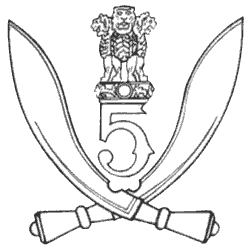
5th Gorkha Rifles, also abbreviated as 5 GR(FF) is an infantry regiment of the Indian Army comprising Gurkha soldiers of Nepalese origin. It was formed in 1858 as part of the British Indian Army. The regiment's battalions served in the First World War (Mesopotamia) and Second World War.

The 5th Indian Infantry Division was an infantry division of the Indian Army during World War II that fought in several theatres of war and was nicknamed the "Ball of Fire". It was one of the few Allied divisions to fight against three different armies - the Italian, German and Japanese armies.
The 23rd Indian Infantry Brigade was an infantry brigade formation of the Indian Army during World War II from 1941 to at least 1947. The brigade was formed in February 1941, at Loralai in India and in June 1941, assigned to the 14th Indian Infantry Division. In March 1942, the brigade was reassigned to the 23rd Indian Infantry Division, just before being renumbered 123rd Indian Infantry Brigade. As the 123rd the brigade served in the Burma Campaign with not only the 23rd but with the 14th again and the 5th Indian Infantry Division.

The 12th Frontier Force Regiment was formed in 1922 as part of the British Indian Army. It consisted of five regular battalions; numbered 1 to 5 and the 10th (Training) Battalion. During the Second World War a further ten battalions were raised. In 1945, the prenominal "12th" was dropped when the British Indian Army dispensed with prenominal numbering of its regiments. After the independence in 1947, it was formed into the Frontier Force Regiment, part of the army of Pakistan.

The 14th Indian Infantry Division was an infantry division of the Indian Army during World War II. It fought in the Arakan Campaign 1942–43, and was subsequently converted into a Training Division, providing drafts of replacements for units of the Fourteenth Army during the Burma Campaign.
The 2nd Indian Infantry Brigade was an infantry brigade formation of the Indian Army during World War II. It was formed in Rawalpindi in September 1939. In October 1940, it was renamed 16th (Independent) Indian Infantry Brigade in November 1941, and left India for Burma. The brigade was caught in the Battle of Sittang Bridge where it suffered heavy losses. Instead of being reformed in September 1942, it was renamed yet again, this time to 116th Indian Infantry Brigade. Attached to the 39th Indian Infantry Division it now provided specialised jungle conversion training. An infantry battalion would spend from four to six months with the brigade, before being sent to the front to replace a tired battalion in one of the fighting divisions.
The 9th Indian Infantry Brigade was an infantry brigade formation of the Indian Army during World War II. Before the war the 9th (Jhansi) Infantry Brigade was a peacetime formation in Meerut district. This brigade was redesignated the 5th Indian Infantry Brigade and a new 9th Brigade was then formed all in September 1939. The new brigade was assigned to the 5th Indian Infantry Division in June 1940 to January 1944. It then spent February attached to the 7th Indian Infantry Division before returning to the 5th Division. The brigade spent two other short periods away from the 5th Division it was attached to the 17th Indian Infantry Division between March and April 1945 and was with the 19th Indian Infantry Division in April 1945, and returned to the 5th for the rest of the war.
The 100th Indian Infantry Brigade was an infantry brigade formation of the Indian Army during World War II. It was formed in April 1920 at Jhansi. The brigade was assigned to the 34th Indian Infantry Division until June 1943, when it was transferred to the 20th Indian Infantry Division until the end of the war. It was known for its participation in Battle of Imphal or known as "Imphal Campaign" where it fought along with other Indian Infantry regiments converged to form the 20th Indian Division and drove back the Japanese Army back to Burma inflicting heavy losses. This was a turning point in the Burma Campaign, part of South-East Asian theatre of World War II.
The 33rd Indian Infantry Brigade was an infantry brigade of the British Indian Army that saw active service in the Indian Army during the Second World War, notably in the Burma Campaign.
The 55th Indian Infantry Brigade was an infantry brigade formation of the Indian Army during World War II. It was formed in India in April 1942 and assigned to the 7th Indian Infantry Division. In July to September 1942, it was attached to the North Western Army. Afterwards the brigade was assigned to the 14th Indian Infantry Division and took part in the Burma Campaign. Apart from a short period in May 1943, the brigade remained with the 14th Division until the end of the war and was 14th Division was allocated as a training division, the brigade was reorganised as a training brigade in June 1943.
The 48th Infantry Brigade, was raised as the 48 Indian Infantry Brigade, in October 1941, at Secunderabad, India. After an initial tenure with 19th Indian Infantry Division, it was transferred to the 17th Indian Infantry Division. In World War II it participated in the Burma campaign and in April 1942 was attached to 1st Burma Division. After the war the brigade returned to India as an independent brigade, and was located at Dhond in August 1947. After India gained Independence in 1947, 48 Indian Infantry Brigade was re-designated as 48 Infantry Brigade. Since then 48 infantry brigade has seen action Goa in 1961, as part of 17 Infantry Division; in the 1962 War in Kameng Frontier Division, Arunachal Pradesh, as part of 4th Infantry Division; and in the 1971 war, as part of 7th Infantry Division. Since the 1970s, 48 Infantry Brigade has been located in Ferozpur, Punjab, as part of 7 Infantry Division.
The 63rd Indian Infantry Brigade was an infantry brigade formation of the Indian Army during World War II. It was formed in January 1942, at Jhansi in India and was assigned to the 23rd Indian Infantry Division and served in the Burma Campaign. In March 1942, it was reassigned to the 17th Indian Infantry Division with whom it remained for the rest of the war apart from in May 1942, when it was attached to the 39th Indian Infantry Division.
The 4th Indian Infantry Brigade was an infantry brigade formation of the Indian Army during World War II. It was formed in September 1939, as the 7th Indian Infantry Brigade and renumbered 4th in June 1940, The brigade was assigned to HQ Rawalpindi District on formation. Then posted to the 26th Indian Infantry Division in April 1942. The brigade also served with the 14th Indian Infantry Division between March and April 1943, and them returned to the 26th Division, where it remained for the rest of the war apart from a short attachment with the 82nd Infantry Division in April 1945.
The 10th Indian Infantry Brigade was an infantry brigade formation of the Indian Army during World War II. It was formed in September 1939. In June 1940 it was assigned to the 5th Indian Infantry Division and in September 1940, sailed for East Africa. The brigade spent time attached to other formations, the 4th Indian Infantry Division between June 1940 and March 1941, and the British 10th Armoured Division between March and June 1942, where it was destroyed during the Battle of Gazala. A new brigade was formed in Egypt and assigned to the 10th Indian Infantry Division, with which it fought in the Italian Campaign from April 1944 until the end of the war.
The 20th Indian Infantry Brigade was an infantry brigade formation of the Indian Army during World War II.
The 21st Indian Infantry Brigade was an infantry brigade formation of the Indian Army during World War II.
The 25th Indian Infantry Brigade was an infantry brigade formation of the Indian Army during World War II. It was formed in February, 1941 at Ahmednagar in India and assigned to the 10th Indian Infantry Division. The brigade was attached to the 8th Indian Infantry Division in August 1941, and took part in the Anglo-Soviet invasion of Iran. Returning to the 10th Indian Division in August 1941, they arrived in the desert just in time for the Battle of Gazala and continued to fight in the Western Desert Campaign and later in the Italian Campaign. While in Italy the brigade was attached to the British 46th Infantry Division from 7 to 11 December 1944.
The Landi Kotal Brigade was an infantry formation of the Indian Army during World War II. It was formed in 1920, for service on the North West Frontier. It was normal practice for newly formed battalions to be posted to the North West Frontier for service before being sent to Africa, Burma or Italy.
The 2nd Burma Infantry Brigade was an Infantry formation of the Burma Army during World War II. It was formed in July 1941. The Brigade was then disbanded in June 1942, and reformed in October 1942, to command battalions of the newly formed Burma Regiment. It was disbanded once again in November 1943. During this time it served with the 1st Burma Division July 1941 to January 1942, the 17th Indian Infantry Division January to March 1942. It then returned to 1st Burma Division.



